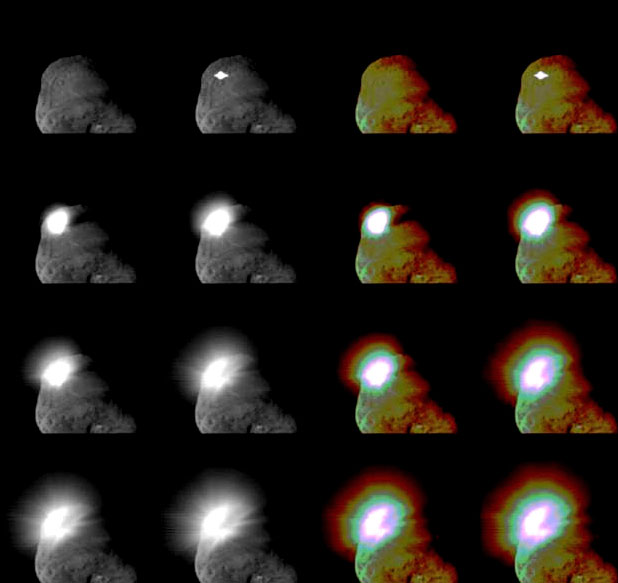-
Missing Water. Proponents of the electric model predicted that Deep
Impact would reveal insufficient water to support the popular ideas
about comets. Now we know the ejected material was largely—perhaps
entirely—dust and vaporized rock.
-
Subsurface Composition. We said that the “impact/electrical
discharge will not reveal ‘primordial dirty ice,’ but the same
composition as the surface.” It is now known that the presence of
volatiles in the coma immediately after impact did not change, with
the exception of changes relating to charge exchange between the
coma and the solar wind (see below).
-
High-Energy Explosion. Wallace Thornhill claimed that the energy of
the “impact” would be greater than expected from impact studies,
because of electrical discharge. When the predicted event occurred,
it left every NASA investigator stunned.
-
Advance Flash. Thornhill predicted that a visible discharge between
the nucleus and impactor would be likely prior to the impactor’s
contact with the surface. At least two flashes are now known to have
occurred, though (for the obvious reasons) no one on NASA’s
investigative team had anticipated this.
-
Explosion Temperatures. Though we’ve found nothing from NASA
relating to the temperatures of the explosion, we said that the
discharge would be “hotter than can be explained by mechanical
impact. If temperature measurements are made with sufficient
resolution, they will be much higher than expected from impact
heating”. On this one we are confident as ever.
-
Explosion Radiance. Within minutes of the impact, the coma of Tempel
1 was overtaken by a blast of light so great that it saturated the
camera’s detectors. NASA spokesmen called this “one of the great
surprises” of Deep Impact. The radiance was not expected under the
model in use. (See “Fine Dust” below).
-
Speed of Transport. Electrical theorists suggest that NASA carefully
review the rate at which ejecta filled the coma. Could kinetic
effects (the effects of physical impact alone) have generated such
speeds? Acceleration of negatively charged material is a predictable
effect of electric discharge.
-
System Failure. Our prediction was: “Electrical stress may short out
the electronics on board the impactor before impact.” The system did
indeed fail a few seconds before impact, and data should be reviewed
to look for indications of electrical breakdown.
-
Multiple craters. We said, “If the energy is distributed over
several flashes, more than one crater on the comet nucleus could
result—in addition to any impact crater”.
Unfortunately, NASA did
not anticipate the volume of dust removed by the explosion, which
may have made it impossible for even the best enhancement technology
to see though the ejecta. However, by tracing rays back to their
source we noted the appearance of two ejecta centers immediately
after the impact.
-
Crater Size. We said, “The impact/electrical discharge will be into
rock, not loosely consolidated ice and dust. The impact crater will
be smaller than expected”.
The occlusion of the impact site by the
unexpected dust cloud leaves this question of crater size
unanswered. (Some NASA investigators have suggested that the impact
did not reach a deep level, but so far the pronouncements on the
subject are quite contradictory because they’re trying to explain
things they did not expect).
-
X-rays. We suggested that X-rays would accompany discharges to the
projectile, “exceeding any reasonable model for X-ray production
through the mechanics of impact. The intensity curve will be that of
a lightning bolt (sudden onset, exponential decline) and may well
include more than one peak”. So far there has been no indication
that any instrument based near or on Earth had the temporal or
spatial resolution to decide this issue.
-
Creation of Water in the Coma. The electric model suggests that
negatively charged oxygen from silicates and other metallic oxides
on the nucleus (a negatively charged object) reacts electrically
with the positively charged hydrogen ions of the solar wind to
create OH. Thus, readings of the relative abundance of OH should
drop in the immediate wake of impact, while in the days after the
impact abundances of OH should rise. Though this is inconceivable
under the standard model, preliminary data released does suggest
this pattern.
-
X-rays from Coma. Thornhill contends that the electrical transaction
between the coma and the solar wind creates the surprising X-rays
emanating from cometary comas. Therefore, we should expect that in
the days following the impact the x-ray curve will tend to follow
that of OH production.
-
Electrostatic Cleaning and Deposition. In our Pictures of the Day we
have noted evidence of both electrostatic cleaning and electrostatic
implantation in space. We are confident that both processes occur on
the nucleus of Tempel 1. Some of the material cleaned from the
surface electrostatically will be accelerated into space. Other
portions of the material, now positively charged, will be
electrostatically drawn to the surface.
-
Collimated Jets. While the electric theorists identify Tempel 1 as a
low voltage comet, enhanced pictures should show clearly visible
jets retaining their coherence over distances that cannot be
maintained by neutral gases in the vacuum of space. All evidence
provided to this point confirms the expectation.
-
Fine Dust. Both the volume of dust and its extraordinarily fine
texture have created mysteries for cometologists. The ejected dust
appears to be as fine as talcum powder. In no sense was this
expected. But it is characteristic of “cathode sputtering”, a
process used industrially to create super-fine deposits or coatings
from cathode materials.
-
Surface Geology. We not only predicted the sharply defined relief,
but the specific features.
“The model predicts a sculpted surface,
distinguished by sharply defined craters, valleys, mesas, and
ridges—the opposite of the softened relief expected of a sublimating
‘dirty snowball’.”
-
Surface Arcing. We had seen very small white spots on photographs of
comet Wild 2, and interpreted them as electrical arcs in the form of
coronal discharges. The highest resolution photographs of Tempel 1,
taken by the impactor, show numerous featureless patches of
white-out, most located where the electrical hypothesis would put
them—on the rims of craters and on the wall of cliffs rising above
flat valley floors.
This single feature, we believe, provides the
“smoking guns” we have waited for. Since their initial suggestion
that the patches could be highly reflective spots on the surface,
we’ve heard no further comment on the subject.
The signature of
electric arcing should be clearly evident in the full stream of data
now being analyzed.

